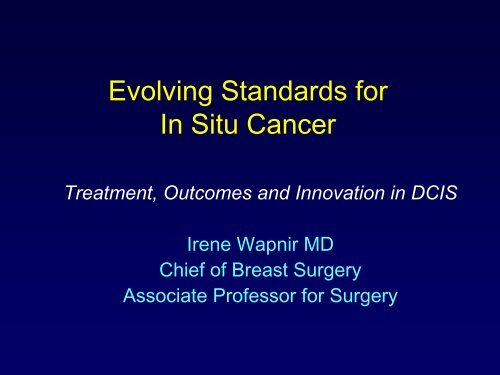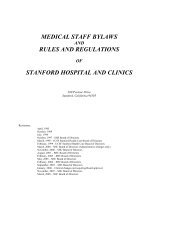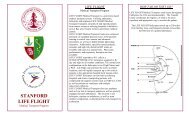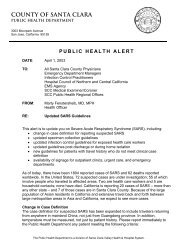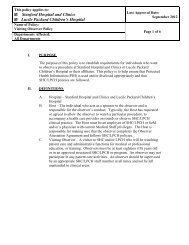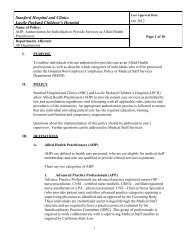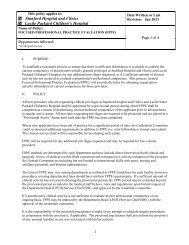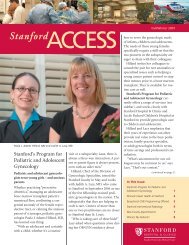Ductal Carcinoma In Situ - Stanford Hospital & Clinics
Ductal Carcinoma In Situ - Stanford Hospital & Clinics
Ductal Carcinoma In Situ - Stanford Hospital & Clinics
Create successful ePaper yourself
Turn your PDF publications into a flip-book with our unique Google optimized e-Paper software.
Evolving Standards for<br />
<strong>In</strong> <strong>Situ</strong> Cancer<br />
Treatment, Outcomes and <strong>In</strong>novation in DCIS<br />
Irene Wapnir MD<br />
Chief of Breast Surgery<br />
Associate Professor for Surgery
Outline<br />
• Changing epidemiology<br />
• Mammographic screening and other breast<br />
imaging modalities<br />
– The utility of MRI<br />
• Surgical treatment<br />
• Retrospective analyses are usually perceived as<br />
“exploratory” or “hypothesis-generating” studies<br />
• Evidence-based outcomes with breast<br />
conserving approaches<br />
• <strong>In</strong>novations in Mastectomy treatment
<strong>In</strong>novations in Surgery for DCIS<br />
• Ductoscopy : a surgical tool<br />
– <strong>In</strong> patients with nipple discharge/detection of<br />
DCIS<br />
– To delineate nipple-side extent of DCIS<br />
• Central Lumpectomy<br />
• Skin-sparing mastectomies<br />
– Nipple-sparing<br />
– <strong>In</strong>traoperative evaluation of skin perfusion<br />
• Partial Breast Irradiation<br />
– <strong>In</strong>traoperative or post-operative approaches
Pathological definitions remained unclear<br />
until 1970s<br />
Not an obligate<br />
precursor of<br />
invasive DCIScancer<br />
Benign Malignant
September 22-24, 2009<br />
… a risk factor for<br />
invasive breast cancer
NIH DCIS Consensus Conference 2009<br />
…the diagnosis and management of DCIS is<br />
highly complex with many unanswered<br />
questions, including the fundamental natural<br />
history of untreated disease.<br />
Because of the noninvasive nature of DCIS,<br />
coupled with its favorable prognosis, strong<br />
consideration should be given to elimination of<br />
the anxiety-producing term “carcinoma”…
Synonyms<br />
• <strong>In</strong>traductal carcinoma<br />
• Non-invasive, or non-infiltrating<br />
• Comedocarcinoma<br />
• Pre-invasive carcinoma<br />
• <strong>Ductal</strong> carcinoma in situ
TYPES OF DCIS<br />
Comedo /high grade Low grade/ cribriform Low grade/ solid<br />
Micropapillary low gr<br />
Low gr papillary<br />
X<br />
Microinvasion in<br />
DCIS<br />
Allred C, 2009 NIH-DCIS Consensus Conference
DNA Microarray Subtypes in Pure DCIS<br />
Similar to IDC<br />
Allred D C et al. Clin Cancer Res 2008;14:370-378
Magnitude of Problem<br />
• ~ 20-25% new BCs<br />
2009______<br />
• 62,280 DCIS<br />
• 192,370 IBC<br />
• By 2020 1 million<br />
survivors
35% increase<br />
500% increase
Age-adjusted incidence rates of different histological types of in situ<br />
breast carcinoma among women ages >=30 years, 1980 to 2001<br />
Li, C. I. et al. Cancer Epidemiol Biomarkers Prev 2005;14:1008-1011<br />
Copyright ©2005 American Association for Cancer Research<br />
SEER Registry Data<br />
All<br />
noncomedo<br />
Comedo DCIS<br />
LCIS
The goal of treating DCIS remains<br />
Prevention of <strong>In</strong>vasive Breast<br />
Overtreatment<br />
Lumpectomy<br />
Cancer<br />
DCIS<br />
Overdiagnosis<br />
Mastectomy<br />
Definitive<br />
Cure
Risk Associations<br />
• Not as strong as invasive breast cancer<br />
– Family history<br />
– Previous biopsies<br />
– Nulliparity and age at 1 st birth<br />
– BMI<br />
– Post-menopausal HRT<br />
• None or conflicting association<br />
– OCP, alcohol, smoking<br />
• Race-ethnicity<br />
– Unlike invasive BC, rates are the same across<br />
races
Hereditary Breast Cancer and DCIS<br />
• Hwang S et al 2007<br />
– Higher grade DCIS in mutation carriers<br />
• Frank et al 2002<br />
– BRCA1/2 mutations were less prevalent in<br />
women< age 50 with<br />
• DCIS 13%<br />
• <strong>In</strong>vasive 24%
Diagnosis<br />
• Detection by palpation is<br />
uncommon<br />
• Widespread use of<br />
mammography increased<br />
detection rates<br />
– Microcalcifications<br />
• Shortcoming : underestimate<br />
extent of disease<br />
• Overdetection ? finding<br />
clinically irrelevant lesions ?
MRI in DCIS<br />
Final path ~ 5.7 cm high grade DCIS<br />
MRI sensitivity for DCIS 38%-100%
• Not all lesions enhance<br />
• MRI can overestimate tumor size<br />
• <strong>In</strong>creases MX conversion rate<br />
(Morrow et al 2008 )<br />
• 47 yr old palpable mass<br />
• Mammography:<br />
• 4 cm spiculated mass<br />
w/microcalcifications<br />
• MRI 6 cm x 4.7 cm<br />
• Pathology : 3.5 cm DCIS
Surgery For DCIS<br />
• MASTECTOMY was the principal treatment for<br />
all BC into 1980s<br />
• Survival nearly 98%-99%<br />
• Chest wall / local recurrences : RARE<br />
• Axillary lymph node dissection was largely<br />
abandoned in 1980s
1985 <strong>In</strong>vasive Breast Cancer<br />
(NSABP B-06)<br />
Lumpectomy+ ALND = MRM
1985-1990<br />
NSABP B-17 B 17<br />
DCIS Treated by Lumpectomy<br />
No Further<br />
Therapy<br />
Negative Margins<br />
Stratification<br />
• Age<br />
• Method of Detection<br />
• Pathologic Characteristics<br />
• Axillary Dissection<br />
Breast<br />
XRT
NSABP B17 – Five year Results: Lumpectomy (open circle)<br />
vs Lumpectomy plus Radiation Therapy<br />
60% lower risk of IBTR with RT
Study No. Follow-<br />
up<br />
NSABP B17<br />
Wapnir et al<br />
1985-1991<br />
Swedish<br />
Holmberg et al<br />
1987-1999<br />
EORTC 108<br />
Bijker et al<br />
1986-1996<br />
UK/ANZ<br />
Houghton et al<br />
1990-1998<br />
Randomized DCIS Trials<br />
Lumpectomy + RT<br />
813 12 y<br />
median<br />
Outcomes RT Decrease<br />
IBTR w/RT<br />
P<br />
value<br />
Cum <strong>In</strong>c 12y 15.8% 52%
SEER : Breast Cancer-Specific Survival<br />
Breast Conservation + RT versus Total Mastectomy<br />
Disease Specific Survival<br />
Probability<br />
1<br />
0.8<br />
0.6<br />
0.4<br />
0.2<br />
0<br />
Logrank p < 0.0001<br />
Ibrahim et al ASCO 2007<br />
0 12 24 36 48 60 72 84 96 108 120<br />
Time (Months)<br />
BCS + RTX Total Mastectomy
DCIS and Nodal Staging<br />
• Not needed for most noninvasive<br />
carcinomas<br />
• EXCEPTION: large<br />
tumors > 5cm<br />
• Maybe high gr/ ? invasion<br />
• SNBX for clinically<br />
node negative pts<br />
• Consideration of<br />
SNBx procedure<br />
exacerbated by use of<br />
core biopsy def Sx
Sentinel Node Biopsy<br />
• Core biopsy --> definitive Sx<br />
• Possibility of upstaging DCIS to microinvasive<br />
or invasive disease 10-38%<br />
• “avoiding a second trip to OR”<br />
• Hypothetical impossibility of performing SNB<br />
after Mx<br />
• Rates reported in single institution series 1.8<br />
to 12% on high grade DCIS
Opinions<br />
• Philadelphia Consensus Conference SNB<br />
2002<br />
• ASCO Guidelines SNB 2005<br />
• City of Hope Cancer Center series:<br />
No nodal recurrence at 14-year 14 year FU<br />
• NCCN Guidelines 2009<br />
• NIH DCIS Consensus 2009<br />
Do not favor SNB routinely in DCIS
Evaluation of XRT<br />
• Data from non-randomized non randomized cohorts<br />
– USC/Van Nuys Experience<br />
• Single arm Prospective Trials (premature closures)<br />
– ECOG 5194<br />
– Dana Farber<br />
– RTOG 98-04 98 04
ECOG 5194 : Omission of Radiation<br />
Two arm prospective study<br />
• Low or intermediate grade 2.5 cm or smaller<br />
(~ X 6 mm)<br />
• High grade 1.0 cm or smaller (~X 5mm)<br />
TAM allowed after 2000<br />
DCIS grade Local Recurrence<br />
5 yr rate 7 yr rate<br />
Low 6.1% 10.5%<br />
High 15.3% 18.0%<br />
Hughes, L. L. et al. J Clin Oncol 2009; 27:5319-5324
ECOG 5194 : Ipsilateral (IBEs) and contralateral breast<br />
events (CBEs) in patients with high-grade DCIS (N=105)<br />
Copyright © American Society of Clinical Oncology<br />
Hughes, L. L. et al. J Clin Oncol; 27:5319-5324 2009
Metanalysis of Local Recurrence<br />
According to Margin S tatus in<br />
DCIS<br />
4,660 Patients BCS+XRT<br />
• Neg vs Pos Margin OR = 0.36<br />
• Neg vs Close Margin OR = 0.59<br />
• Close vs Pos Margin OR = 0.43<br />
• 2 mm vs < 2 mm OR = 0.53<br />
• No difference when margin 2mm or >5mm<br />
Dunne et al J Clin Oncol 2009
Completed NSABP Randomized DCIS Trials<br />
Lumpectomy<br />
Negative Margins<br />
No Further<br />
Therapy<br />
1985-1990<br />
Breast<br />
XRT<br />
1991-1994<br />
Lumpectomy +XRT + XRT<br />
75% Negative Margins<br />
Placebo Tamoxifen
IBTR<br />
• 2,612 randomized women with follow-up<br />
• 490 IBTR (1st failures)<br />
– 227 noninvasive (DCIS) 46.3%<br />
– 263 invasive 53.7%
IBTR Events by Trial<br />
B-17* & B-24 ALL IBTR Noninvasive <strong>In</strong>vasive<br />
LO<br />
N= 403<br />
LRT B17<br />
N= 410<br />
LRT B24<br />
N=900<br />
LRT+TAM<br />
N= 899<br />
35.0% 15.4% 19.6%<br />
19.8% 9.0% 10.7%<br />
16.6% 7.6% 9.0%<br />
13.2% 6.7% 6.6%<br />
* % on B-17 will be higher irrespective of rates, due to longer follow-up
DCIS-IBTR : Cumulative <strong>In</strong>cidence<br />
15 year<br />
LO 15.7%<br />
LRT B-17 8.7%<br />
LRT B-24 8.5%<br />
LRT+TAM 7.5%<br />
Wapnir, Dignam, et al 2010
<strong>In</strong>vasive-IBTR : Cumulative <strong>In</strong>cidence<br />
15 year<br />
LO 19.4%<br />
LRT B-24 10.0%<br />
LRT B-17 8.9%<br />
LRT+TAM 8.5%<br />
Wapnir, Dignam, et al 2010
All Contralateral Cancers<br />
Wapnir, Dignam, et al 2010
Cumulative <strong>In</strong>cidence of I-IBTR by<br />
Margin Status in NSABP B-24<br />
LRT inv marg 17.4%<br />
LRT+TAM inv marg<br />
11.5%<br />
LRT+TAM free mar<br />
7.5%<br />
LRT free marg 7.4%<br />
Wapnir, Dignam et al 2010
Mortality Risk after DCIS-IBTR<br />
• <strong>In</strong>creased mortality for patients who<br />
experience invasive-IBTR:<br />
– HR = 2.07 (95% CI 1.45 - 2.96)<br />
• No increase in mortality for patients<br />
who experience DCIS-IBTR:<br />
– HR= 0.77 (95% CI 0.46-1.28)
Proportion of Patients Experiencing<br />
Other (non-IBTR) First Failure Events<br />
B17 & B24<br />
LO<br />
N= 403<br />
LRT<br />
N= 1310<br />
LRT+TAM<br />
N= 899<br />
Second<br />
Primaries<br />
Distant<br />
Recurrences<br />
5.7% 1.0%<br />
7.3% 0.8%<br />
7.5% 0.4%
NSABP B-24: Cumulative <strong>In</strong>cidence of<br />
All Breast Cancer Events<br />
% All Breast Cancers<br />
40<br />
35<br />
30<br />
25<br />
20<br />
15<br />
10<br />
5<br />
0<br />
Trt<br />
L+XRT Plac<br />
L+XRT TAM<br />
N<br />
900<br />
899<br />
Evts<br />
232<br />
170<br />
HR<br />
0.69<br />
p‐value<br />
0.0002<br />
0 2 4 6 8 10 12<br />
Years after Surgery<br />
24.5<br />
18.0
Cumulative incidence of deaths attributable<br />
to breast cancer<br />
Wapnir, Dignam et al 2010
Mortality after BCT for DCIS<br />
Non-breast CA<br />
related deaths<br />
313<br />
Randomized<br />
2612<br />
Total Deaths 385<br />
Breast CA-<br />
specific deaths<br />
72*<br />
* Encompasses ALL BC related deaths
Outcomes after I-IBTR<br />
• Median follow-up post I-IBTR ~ 84 months<br />
• 39 deaths (14.8%) among 263 I-IBTR cases<br />
22 BC-related<br />
8.4 %<br />
All Patients<br />
0.84%
<strong>In</strong>novations in Surgery for<br />
DCIS
Ductoscopic Appearance of DICS<br />
Solid and<br />
cribriform
Central Areolar-sparing Lumpectomy
Alternatives to Post-lumpectomy<br />
Whole Breast Radiation Therapy<br />
Whole breast<br />
Partial breast
Resurgence of Mastectomy<br />
Freedom from Recurrence and from Continuous Surveillance<br />
Myocutaneous flap<br />
Implant reconstruction
Nipple-sparing Mastectomy<br />
24 hours postsurgery
Tumor <strong>In</strong>volvement of Nipple-areola<br />
Complex<br />
• Fisher E et al (B-04) 1975 : 11%<br />
• Lagios et al 1979 : 30%<br />
• Morimoto et al 1985 : 31%<br />
• Santini et al 1989 : 12%<br />
• Laronga et al MD Anderson 1999 : 5.6%<br />
– Areolar involvement on Mx ~0.9%
Nipple-sparing Mastectomy<br />
• Alternative<br />
• Historically 0% - 58% of<br />
nipple involved with tumor<br />
• 21% of 232 Mx<br />
specimens had nipple<br />
involvement (IC, DCSI,<br />
LVI)<br />
• 10% DCIS cases had<br />
nipple involvement<br />
Brachtel, E. F. et al. J Clin Oncol; 27:4948-4954 2009<br />
PROCEDURE : Subcutaneous dissection<br />
and coring out of nipple ducts
Complications of Total Skin-sparing<br />
Mastectomy<br />
• Nipple necrosis 5%<br />
• Skin flap necrosis 11%<br />
• Significant infection 9%<br />
• Implant loss 10%<br />
• Contracture (implants only) 16%<br />
Garwood et al Ann Surg 249: 26; 2009
DCIS<br />
7.5 cm suspicious<br />
enhancement<br />
Ultrasound : 2.4 cm<br />
Pathology : 3.6 cm x 1.8 cm<br />
micropapillary intermed gr
Pre Nipple sparing mastectomy
Post op TE -240cc Post op TE -180cc
Contralateral Prophylactic Mastectomy<br />
Rates in DCIS<br />
Tuttle, T. M. et al. J Clin Oncol; 27:1362-1367 2009<br />
ALL Mastectomy Patients with CPM (DCIS-SEER)
Three weeks post operative after second expansion (total 400 ml)<br />
PLAN: Complete expansion, right chest wall irradiation and<br />
delayed permanent implant exchange
Current and Future Directions<br />
• Genomic analysis of DCIS subtypes<br />
• Improving prognostic molecular tools<br />
• Expanding the repertoire of targeted<br />
therapies<br />
– ER+ (tamoxifen and AI)<br />
– HER2neu (trastuzumab)
Outcomes and QOL Issues in DCIS<br />
• Human costs of overdiagnosis<br />
– Toxicity, time, money<br />
• “Generalized fear of breast cancer and the<br />
marketing of early diagnosis for a disease<br />
that kills very few…”<br />
Ganz P. NIH DCIS Consensus 2009


